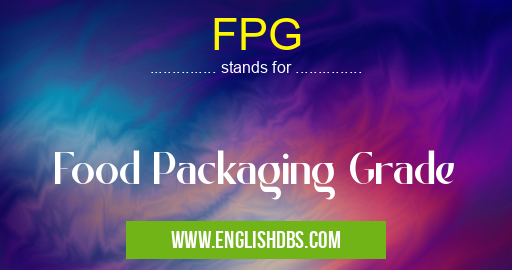What does FPG mean in FOOD & NUTRITION
FPG (Food Packaging Grade) refers to a specific grade of materials used in the packaging of food products. These materials adhere to stringent standards and regulations to ensure the safety and preservation of food items.

FPG meaning in Food & Nutrition in Miscellaneous
FPG mostly used in an acronym Food & Nutrition in Category Miscellaneous that means Food Packaging Grade
Shorthand: FPG,
Full Form: Food Packaging Grade
For more information of "Food Packaging Grade", see the section below.
Key Points
- Materials: FPG materials include plastics, metals, paper, and glass.
- Standards: FPG materials meet specific criteria for food contact safety, including:
- FDA Approval: Materials are approved by the US Food and Drug Administration (FDA) for use in food packaging.
- EU Regulations: Materials comply with European Union (EU) regulations on food contact materials.
- International Standards: They conform to international standards such as ISO 22000 and BRC Global Standards.
- Properties: FPG materials possess essential properties for food packaging:
- Inert: They do not react with or contaminate food.
- Protective: They shield food from external factors like moisture, oxygen, and microorganisms.
- Durable: They withstand the rigors of storage, transportation, and handling.
- Benefits: Using FPG materials in food packaging:
- Ensures food safety and hygiene.
- Preserves the quality and freshness of food products.
- Complies with legal and regulatory requirements.
- Applications: FPG materials are found in a wide range of food packaging, including:
- Bottles and jars
- Flexible packaging (bags, pouches)
- Cans and lids
- Paperboard boxes and cartons
Essential Questions and Answers on Food Packaging Grade in "MISCELLANEOUS»FOOD"
What is Food Packaging Grade (FPG)?
Food Packaging Grade (FPG) refers to materials and processes that are specifically designed and approved for use in packaging food products. FPG materials meet rigorous safety standards to prevent contamination and ensure the safe consumption of food.
Why is FPG important?
FPG is essential to protect consumers from potential health hazards associated with food contamination. Non-FPG materials may contain harmful chemicals or bacteria that can leach into food, causing foodborne illnesses. FPG ensures that packaging materials do not compromise the safety or quality of the food they contain.
What are the key requirements for FPG materials?
FPG materials must meet specific criteria, including:
- Inertness: Materials must not react with or contaminate food.
- Non-toxic: Materials must not release harmful substances into food.
- Impermeability: Materials must prevent moisture, oxygen, and other contaminants from entering or escaping the package.
- Durability: Materials must withstand transportation, handling, and storage conditions without compromising their integrity.
Which materials are commonly used for FPG packaging?
Common FPG materials include:
- Plastics (e.g., polyethylene, polypropylene, PET)
- Metals (e.g., aluminum, tin)
- Glass
- Paper and paperboard (with appropriate coatings)
How are FPG materials tested and approved?
FPG materials undergo rigorous testing to ensure their safety and compliance with regulations. This includes:
- Chemical analysis to verify their inertness and non-toxicity
- Migration studies to assess the transfer of substances from the material into food
- Physical testing to evaluate their strength, durability, and impermeability
Final Words: FPG (Food Packaging Grade) is a critical aspect of food safety, ensuring that packaging materials meet rigorous standards to protect food products from contamination and spoilage. By using FPG materials, food manufacturers and consumers can be confident that the food they consume is safe and of the highest quality.
